Seasonal Precipitation Variability and Non-Stationarity Based on the Evolution Pattern of the Indian Ocean Dipole over the East Asia Region
Abstract
1. Introduction
2. Materials and Methods
2.1. Data
2.2. Classification of IOD Events
- (1)
- Pre-processing of data: SST anomalies in the Western Indian Ocean (10°S–10°N, 60°–80°E) and eastern Indian Ocean (10°S–0°, 90°–110°E), and zonal wind anomalies over the equator (, area-averaged wind anomaly over 5°S–5°N, 70°–90°E), were first detrended. A three-month running mean was then applied once over the three time-series datasets to reduce the impact of intra-seasonal fluctuations;
- (2)
- Identifying criteria: The DMI and needed to exceed 0.5 in amplitude for at least three months. In addition, the SSTA in the west and east Indian Ocean have opposite signs, and the magnitude should exceed 0.5 for at least three months.
2.3. Singular Spectrum Analysis
2.4. Mutual Information
3. Analysis and Results
3.1. Nonlinear Atmospheric Teleconnections over the KP
3.2. Evolution Pattern of the Indian Ocean Dipole and Its Local Impacts over the KP
3.3. Nonstationarity of Seasonal Precipitation Anomalies for Different Phases of the IOD
3.4. Large-Scale Air–Sea Environment and Precipitation Variations over East Asia
4. Conclusions
- (1)
- The analysis of atmospheric teleconnections was conducted using PCA and SSA techniques. Non-linear lag correlations between climate indices and seasonal precipitation were calculated using the MI technique, and their lag-time correlations were simulated from lag-0 to lag-11. Teleconnection-based non-linear and linear CCs were conducted between climate indices and seasonal precipitation using LR and KDE based on the MI results. Results from non-linear CCs were higher than those from linear correlations, and IOD was found to directly influence the precipitation anomaly time series over the KP. This study demonstrates a method for teleconnection-based long-range water resource management to reduce climate uncertainty when an abnormal SSTA occurs in the TIO region;
- (2)
- When the IOD reached its peak (August to October), a significant decrease in seasonal precipitation during the n-IOD period was observed throughout the KP. For the spring period (March to May), seasonal precipitation during p-IOD years coincided with the El Niño phenomenon, which was higher than those of only p-IOD years. These changes occurred more frequently in the CT El Niño than in the WP El Niño years. For the co-occurrence of n-IODs and La Niña, there was greater precipitation than when only n-IODs occurred in isolation;
- (3)
- The characteristics of non-stationary 30-year averaged seasonal precipitation were detected throughout the KP. The precipitation in autumn (August to October) was observed to increase significantly (p < 0.001) when excluding the p-IOD year across the KP. In contrast, seasonal precipitation in the central river basins of KP had plummeted since 2013 and decreased in the southern basins of the KP since 2007. Spring precipitation showed statistically significant declines across the five major rivers in the KP when IODs peaked and entered a period of decline. The decline in seasonal precipitation from March to May was noticeable in the southern coastal regions of Korea;
- (4)
- During p-IOD years, there were more precipitation signals than usual in the southern part of China, including the SCS and the southern part of Japan, with cyclonic circulation patterns. A high-pressure anti-cyclonic pattern was observed over eastern China and the KP. There was a drier signal in n-IOD years than normal in the SCS and southern China, along with a high-pressure anti-cyclonic pattern. Conversely, inland and eastern regions of China and Japan showed wetter signals than usual, with a cyclonic circulation pattern. However, the KP was located between the two cyclonic circulations, and the district precipitation signal was not visible. The signal was less dry than the p-IOD years.
Author Contributions
Funding
Data Availability Statement
Acknowledgments
Conflicts of Interest
References
- Wang, B.; Wu, R.; Fu, X. Pacific-East Asia Teleconnection: How Does ENSO Affect East Asian Climate? J. Clim. 2000, 13, 1517–1536. [Google Scholar] [CrossRef]
- Pizarro, G.; Lall, U. El Niño-induced flooding in the U.S. West: What can we expect? Eos Trans. Am. Geophys. Union. 2002, 83, 349–352. [Google Scholar] [CrossRef]
- IPCC (Intergovernmental Panel on Climate Change). Managing the Risks of Extreme Events and Disasters to Advance Climate Change Adaptation (SREX)—Special Report of the Intergovernmental Panel on Climate Change; Cambridge University Press: Cambridge, UK, 2007; pp. 1–594. [Google Scholar]
- Horel, J.D.; Wallace, J.M. Planetary-scale atmospheric phenomena associated with the Southern Oscillation. Mon. Weather Rev. 1981, 109, 813–829. [Google Scholar] [CrossRef]
- Kim, J.S.; Jain, S.; Yoon, S.K. Warm season streamflow variability in the Korean Han River Basin: Links with atmospheric teleconnections. Int. J. Clim. 2012, 32, 635–640. [Google Scholar] [CrossRef]
- Yoon, S.K.; Kim, J.S.; Lee, J.H.; Moon, Y.I. Hydrometeorological variability in the Korean Han River Basin and its sub-watersheds during different El Niño phases. Stoch. Environ. Res. Risk Assess. 2013, 27, 1465–1477. [Google Scholar] [CrossRef]
- Lee, T.S.; Ouarda, T.; Yoon, S.K. KNN-based Local Linear Regression for the Analysis and Simulation of Low Flow Extremes under Climatic Influence. Clim. Dyn. 2017, 49, 3493–3511. [Google Scholar] [CrossRef]
- Piechota, T.C.; Dracup, J.A. Drought and regional hydrologic variation in the United States: Associations with the El Niño-Southern Oscillation. Water Resour. Res. 1996, 32, 1359–1373. [Google Scholar] [CrossRef]
- Piechota, T.C.; Chiew, H.S.; Francis Dracup, J.A.; McMachon, T.A. Seasonal streamflow forecasting in eastern Australia and the El Niño-Southern Oscillation. Water Resour. Res. 1998, 34, 3035–3044. [Google Scholar] [CrossRef]
- Saji, N.H.; Goswami, B.N.; Vinayachandran, P.N.; Yamagata, T. A dipole mode in the tropical Indian Ocean. Nature 1999, 401, 360–363. [Google Scholar] [CrossRef] [PubMed]
- Yoon, S.K.; Lee, T. Investigation of hydrological variability in the Korean Peninsula with the ENSO teleconnections. Proc. Int. Associ. Hydrol. Sci. 2016, 374, 165–173. [Google Scholar] [CrossRef]
- Kim, J.-S.; Xaiyaseng, P.; Xiong, L.; Yoon, S.-K.; Lee, T. Remote Sensing-Based Rainfall Variability for Warming and Cooling in Indo-Pacific Ocean with Intentional Statistical Simulations. Remote Sens. 2020, 12, 1458. [Google Scholar] [CrossRef]
- Ashok, K.; Guan, Z.; Yamagata, T. Influence of the Indian Ocean dipole on the Australian winter rainfall. Geophys. Res. Lett. 2003, 30, 1821. [Google Scholar] [CrossRef]
- McPhaden, M.J.; Zebiak, S.E.; Glantz, M.H. ENSO as an integrating concept in Earth Science. Science 2006, 314, 1740–1745. [Google Scholar] [CrossRef] [PubMed]
- Pradhan, P.K.; Preethi, B.; Ashok, K.; Krishna, R.; Sahai, A.K. Modoki, Indian Ocean Dipole, and western North Pacific typhoons, Possible implications for extreme events. J. Geophys. Res. 2011, 116, D18108. [Google Scholar] [CrossRef]
- Klein, S.A.; Soden, B.J.; Lau, N.C. Remote sea surface temperature variations during ENSO, Evidence for a tropical atmospheric bridge. J. Clim. 1999, 12, 917–932. [Google Scholar] [CrossRef]
- Lau, N.C.; Nath, M.J. Atmosphere-ocean variations in the Indo-Pacific sector during ENSO episodes. J. Clim. 2003, 16, 3–20. [Google Scholar] [CrossRef]
- Behera, S.K.; Krishnan, R.; Yamagata, T. Unusual ocean-atmosphere conditions in the tropical Indian Ocean during 1994. Geophys. Res. Lett. 1999, 26, 3001–3004. [Google Scholar] [CrossRef]
- Webster, P.J.; Moore, A.M.; Loschnigg, J.P.; Leben, R.R. Coupled ocean–atmosphere dynamics in the Indian Ocean during 1997–98. Nature 1999, 401, 356–360. [Google Scholar] [CrossRef] [PubMed]
- Saji, N.H.; Yamagata, T. Structure of SST and Surface Wind Variability during Indian Ocean Dipole Mode Events, COADS Observations. J. Clim. 2003, 16, 2735–2751. [Google Scholar] [CrossRef]
- Liu, Y.; Yoon, S.-K.; Kim, J.-S.; Xiong, L.; Lee, J.-H. Changes in Intensity and Variability of Tropical Cyclones over the Western North Pacific and Their Local Impacts under Different Types of El Niños. Atmosphere 2021, 12, 59. [Google Scholar] [CrossRef]
- Enomoto, T.; Hoskins, B.J.; Matsuda, Y. The formation of the Bonin high in August. Q. J. R. Meteorol. Soc. 2003, 587, 157–178. [Google Scholar] [CrossRef]
- Guan, Z.; Yamagata, T. The unusual summer of 1994 in East Asia: IOD Teleconnections. Geophys. Res. Lett. 2003, 30, 1544. [Google Scholar] [CrossRef]
- Cherchi, A.; Annamalai, H.; Masina, S.; Navarra, A.; Alessandri, A. Twenty-first century projected summer mean climate in the Mediterranean interpreted through the monsoon-desert mechanism. Clim. Dyn. 2016, 47, 2361–2371. [Google Scholar] [CrossRef]
- Zhang, Y.; Zhou, W.; Chow, E.C.H.; Leung, M.Y. Delayed impacts of the IOD: Cross-seasonal relationships between the IOD, Tibetan Plateau snow, and summer precipitation over the Yangtze–Huaihe River region. Clim. Dyn. 2019, 53, 4077–4093. [Google Scholar] [CrossRef]
- Weng, H.; Wu, G.; Liu, Y.; Behera, S.K.; Yamagata, T. Anomalous summer climate in China influenced by the tropical Indo-Pacific Oceans. Clim. Dyn. 2011, 36, 769–782. [Google Scholar] [CrossRef][Green Version]
- Cai, W.; van Rensch, P.; Cowan, T.; Hendon, H.H. Teleconnection pathways of ENSO and the IOD and the mechanisms for impacts on Australian rainfall. J. Clim. 2011, 24, 3910–3923. [Google Scholar] [CrossRef]
- Kosaka, Y.; Xie, S.P. Recent global-warming hiatus tied to equatorial Pacific surface cooling. Nature 2013, 501, 403–407. [Google Scholar] [CrossRef] [PubMed]
- Lee, S.K.; Park, W.; Baringer, M.O.; Gordon, A.L.; Huber, B.; Liu, Y. Pacific origin of the abrupt increase in Indian Ocean heat content during the warming hiatus. Nat. Geosci. 2015, 8, 445–449. [Google Scholar] [CrossRef]
- Liu, W.; Xie, S.P.; Lu, J. Tracking ocean heat uptake during the surface warming hiatus. Nat. Commun. 2016, 7, 10926. [Google Scholar] [CrossRef]
- Zheng, X.T.; Xie, S.P.; Liu, Q. Response of the Indian Ocean Basin Mode and Its Capacity Effect to Global Warming. J. Clim. 2012, 24, 6146–6164. [Google Scholar] [CrossRef]
- Qu, X.; Huang, G. An Enhanced Influence of Tropical Indian Ocean on the South Asia High after the Late 1970s. J. Clim. 2012, 25, 6930–6941. [Google Scholar] [CrossRef]
- Roxy, M.K.; Gnanaseelan, C.; Parekh, A.; Chowdary, J.S.; Singh, S.; Modi, A.; Kakatkar, R.; Mohapatra, S.; Dhara, C.; Shenoi, S.C.; et al. Indian Ocean Warming. In Assessment of Climate Change over the Indian Region; Krishnan, R., Sanjay, J., Gnanaseelan, C., Mujumdar, M., Kulkarni, A., Chakraborty, S., Eds.; Springer: Singapore, 2020. [Google Scholar] [CrossRef]
- Moon, Y.I.; Lall, U. Atmospheric flow indices and interannual Great Salt Lake variability. J. Hydrol. Eng. 1996, 1, 55–62. [Google Scholar] [CrossRef]
- Moon, Y.I.; Rajagopalan, B.; Lall, U. Estimation of mutual information using kernel density estimators. Phys. Rev. E 1995, 52, 2318–2321. [Google Scholar] [CrossRef] [PubMed]
- Martinerie, J.M.; Albano, A.M.; Mees, A.I.; Rapp, P.E. Mutual Information, Strange Attractors, and the Optimal Estimation of Dimension. Phys. Rev. A 1992, 45, 7058–7064. [Google Scholar] [CrossRef] [PubMed]
- Gao, J.; Zheng, Z. Direct dynamical test for deterministic chaos and optimal embedding of a chaotic time series. Phys. Rev. E 1994, 49, 3807. [Google Scholar] [CrossRef]
- Joe, H. Relative entropy measures of multivariate dependence. J. Am. Stat. Assoc. 1989, 84, 157–164. [Google Scholar] [CrossRef]
- Granger, C.; Lin, J. Using the mutual information coefficients to identify lags in nonlinear models. J. Time. Ser. Anal. 1994, 15, 371–384. [Google Scholar] [CrossRef]
- Chavez, M.; Cazelles, B. Detecting dynamic spatial correlation patterns with generalized wavelet coherence and non-stationary surrogate data. Sci. Rep. 2019, 9, 7389. [Google Scholar] [CrossRef]
- Yu, B.; Lupo, A.R. Large-Scale Atmospheric Circulation Variability and Its Climate Impacts. Atmosphere 2019, 10, 329. [Google Scholar] [CrossRef]
- Perlwitz, J.; Knutson, T.; Kossin, J.P.; LeGrande, A.N. Large-scale circulation and climate variability. In Climate Science Special Report: Fourth National Climate Assessment, Volume I; Wuebbles, D.J., Fahey, D.W., Hibbard, K.A., Dokken, D.J., Stewart, B.C., Maycock, T.K., Eds.; U.S. Global Change Research Program: Washington, DC, USA, 2017; pp. 61–184. [Google Scholar] [CrossRef]
- Yang, J.; Liu, Q.; Xie, S.-P.; Liu, Z.; Wu, L. Impact of the Indian Ocean SST basin mode on the Asian summer monsoon. Geophys. Res. Lett. 2007, 34, L02708. [Google Scholar] [CrossRef]
- Yuan, Y.; Yang, H.; Zhou, W.; Li, C. Influences of the Indian Ocean dipole on the Asian summer monsoon in the following year. Int. J. Clim. 2008, 28, 1849–1859. [Google Scholar] [CrossRef]
- Qui, Y.; Cai, W.; Guo, X.; Ng, B. The asymmetric influence of the positive and negative IOD events on China’s rainfall. Sci. Rep. 2014, 4, 4943. [Google Scholar] [CrossRef]
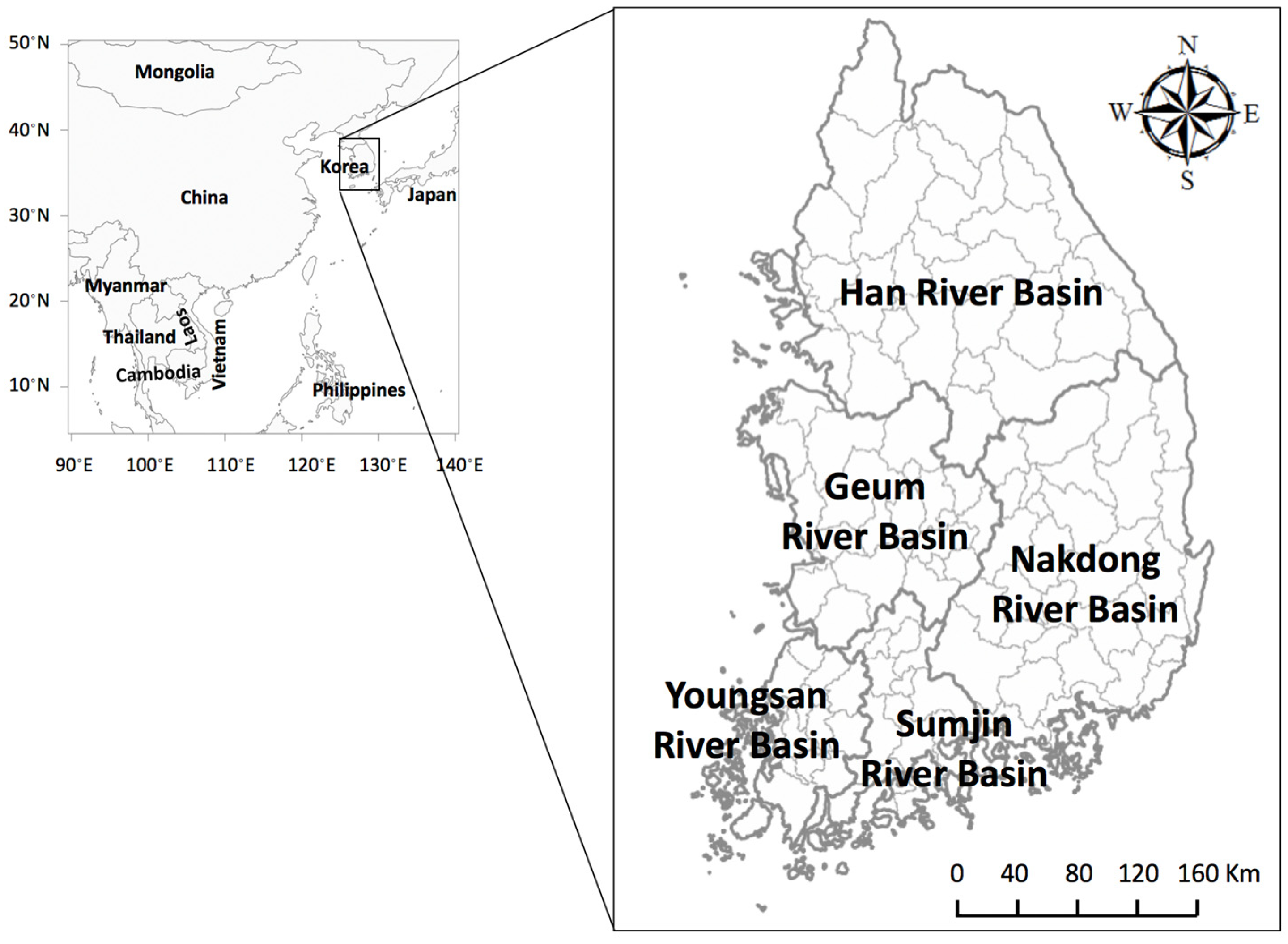

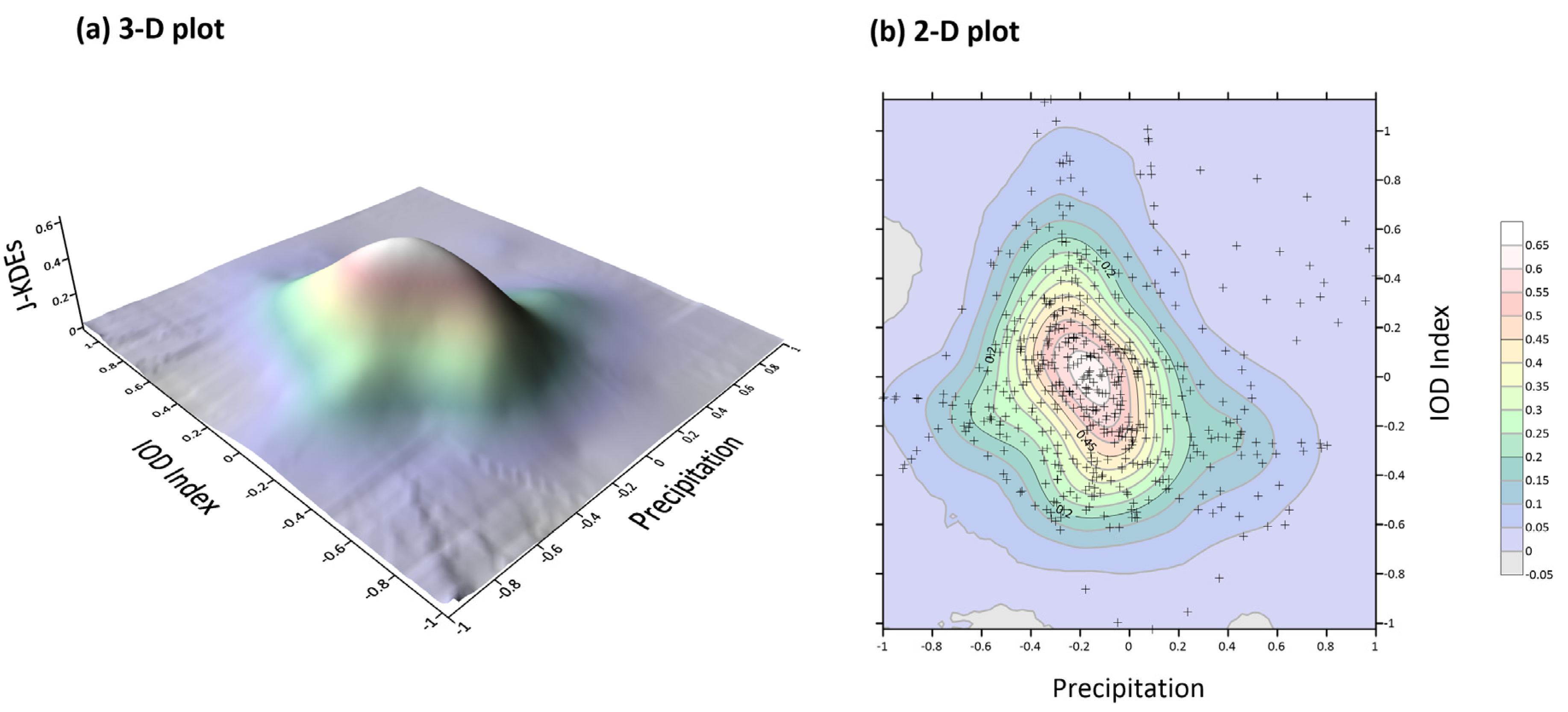
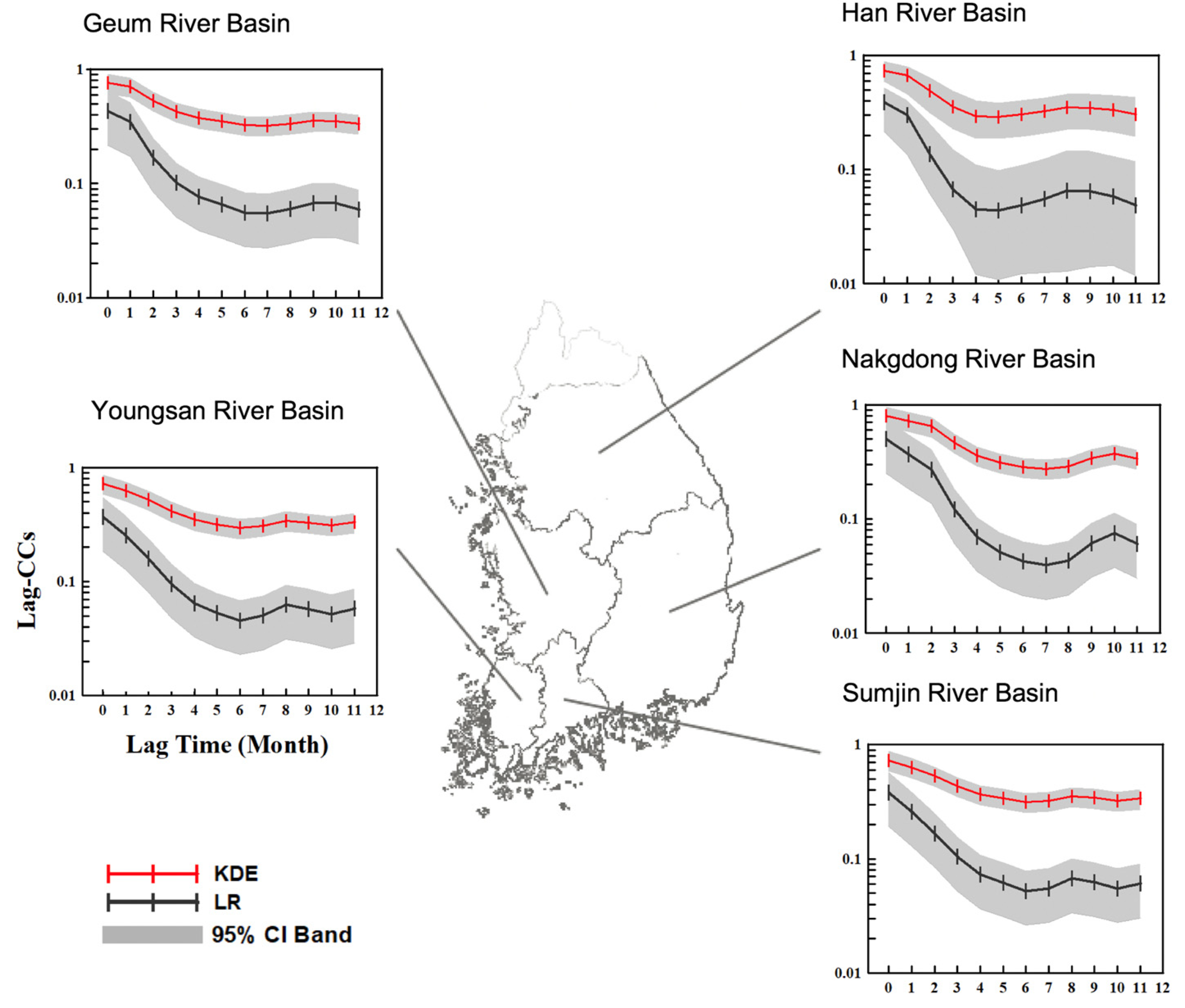
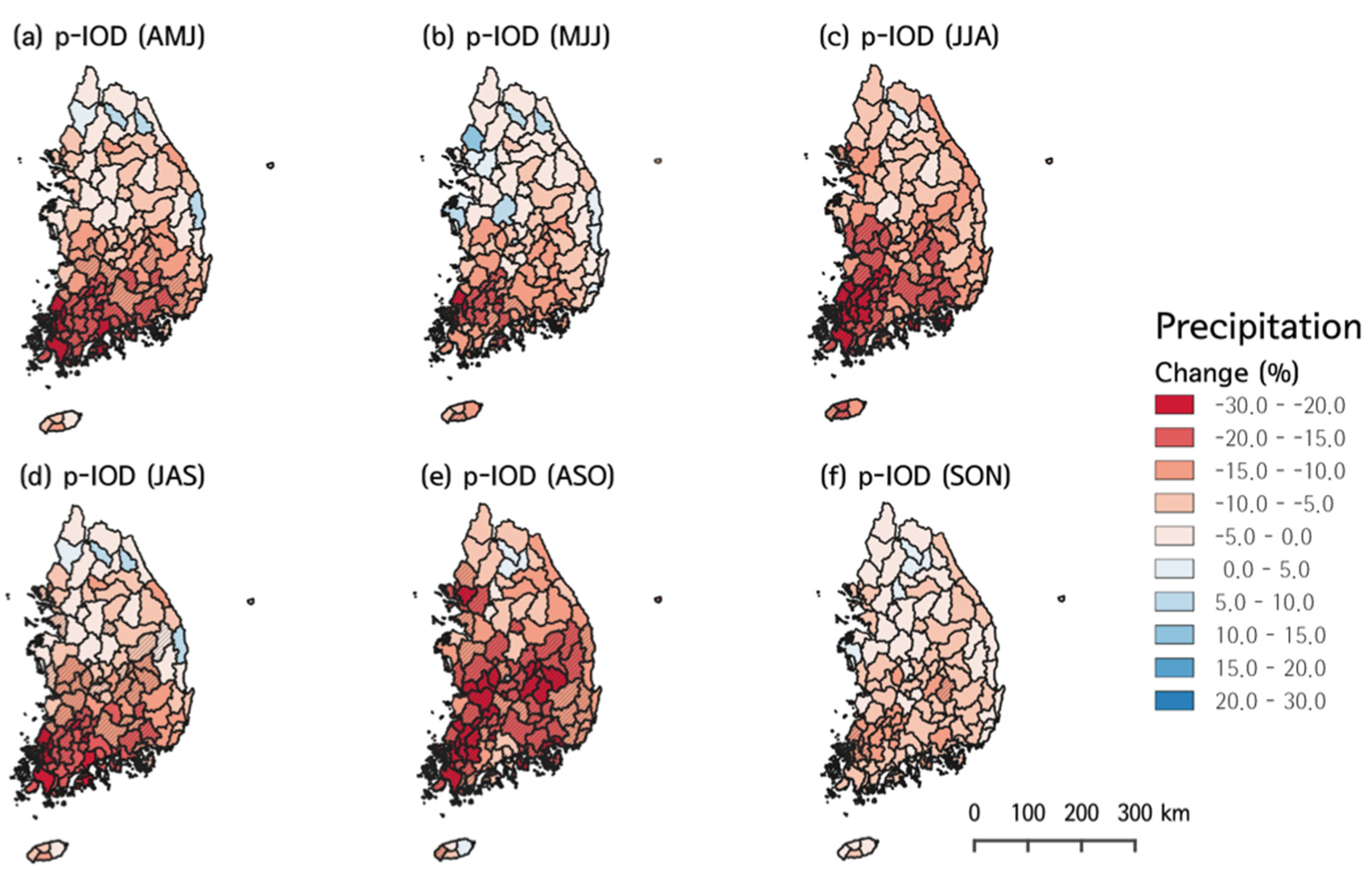
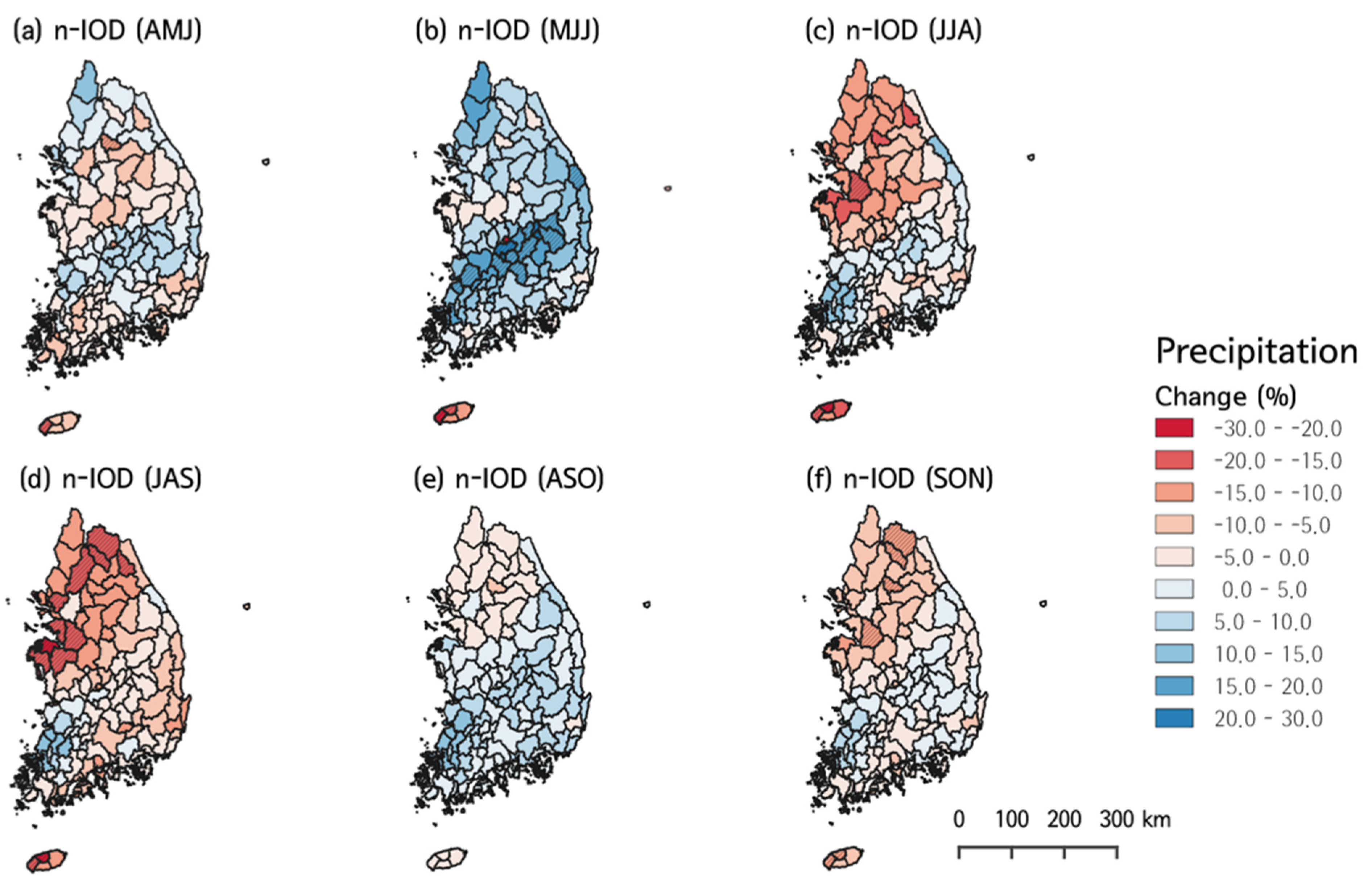
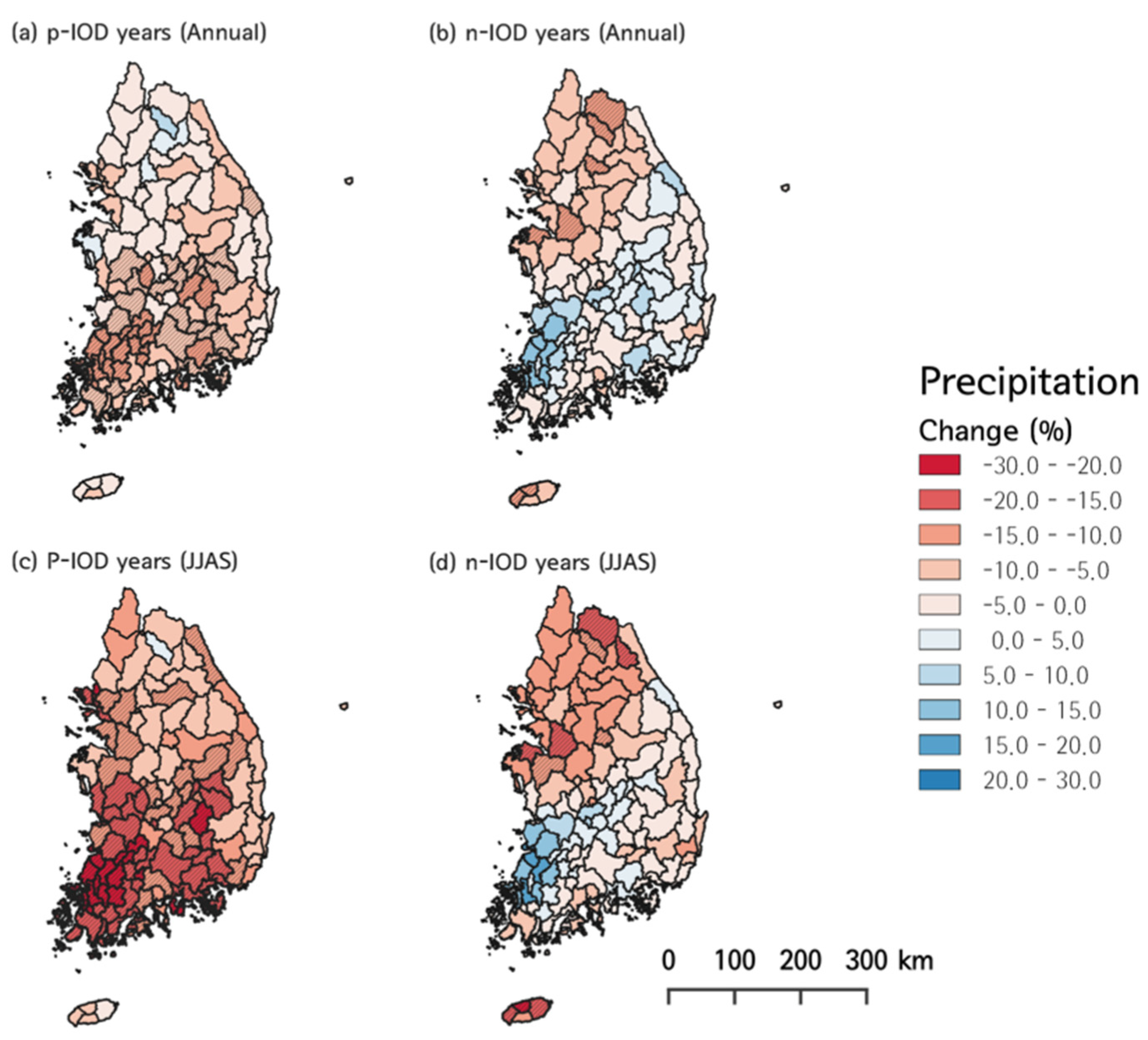
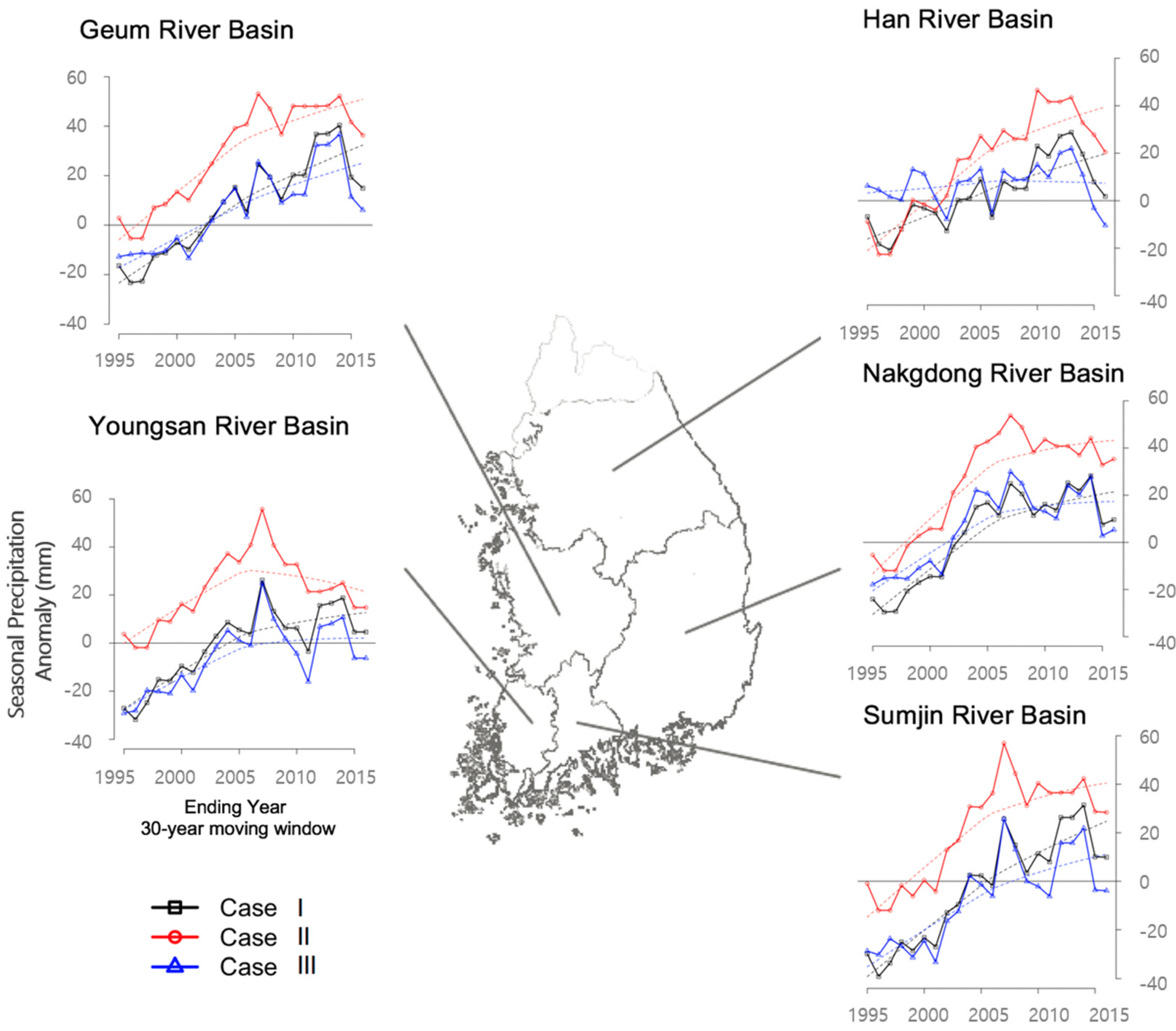
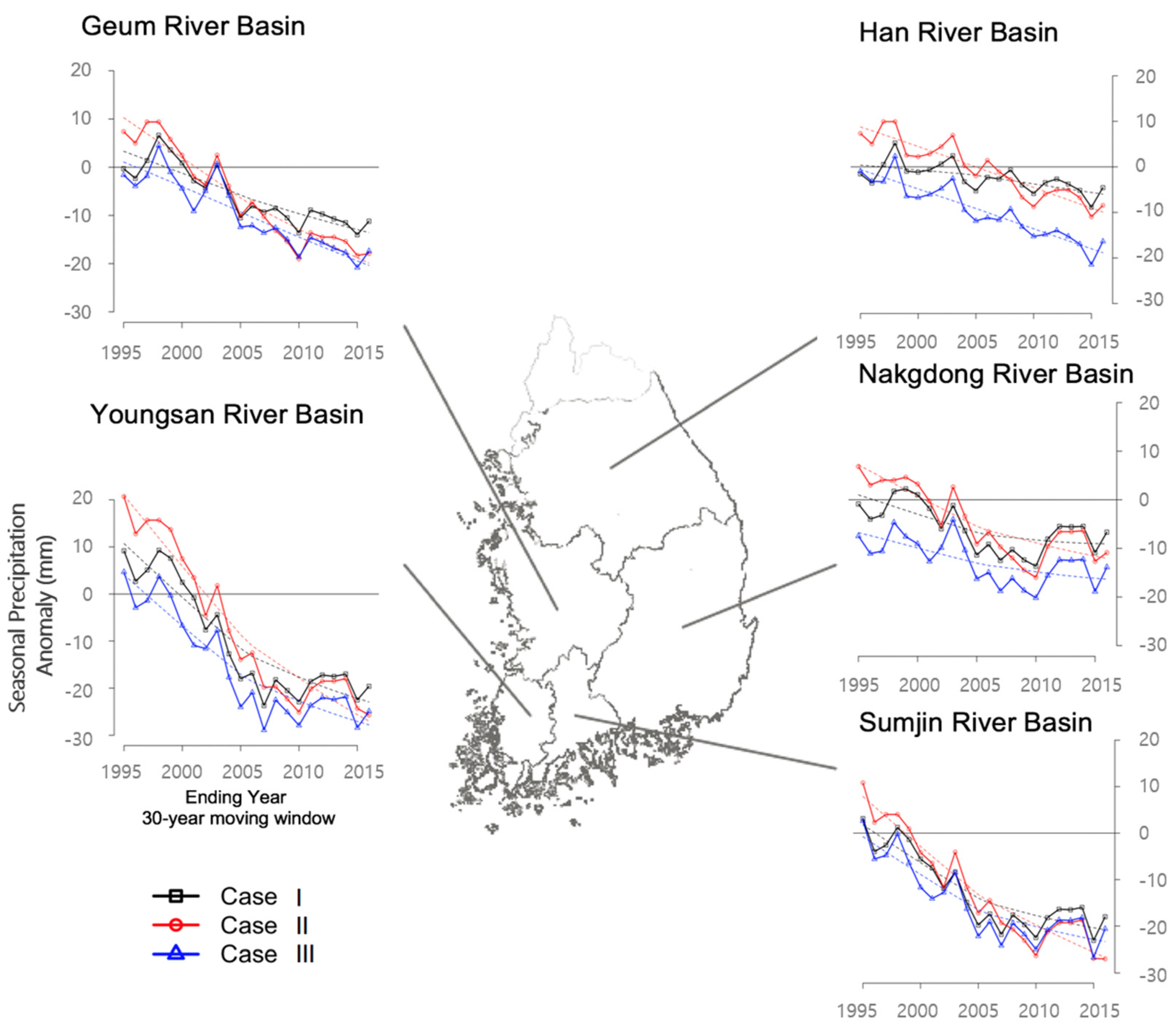
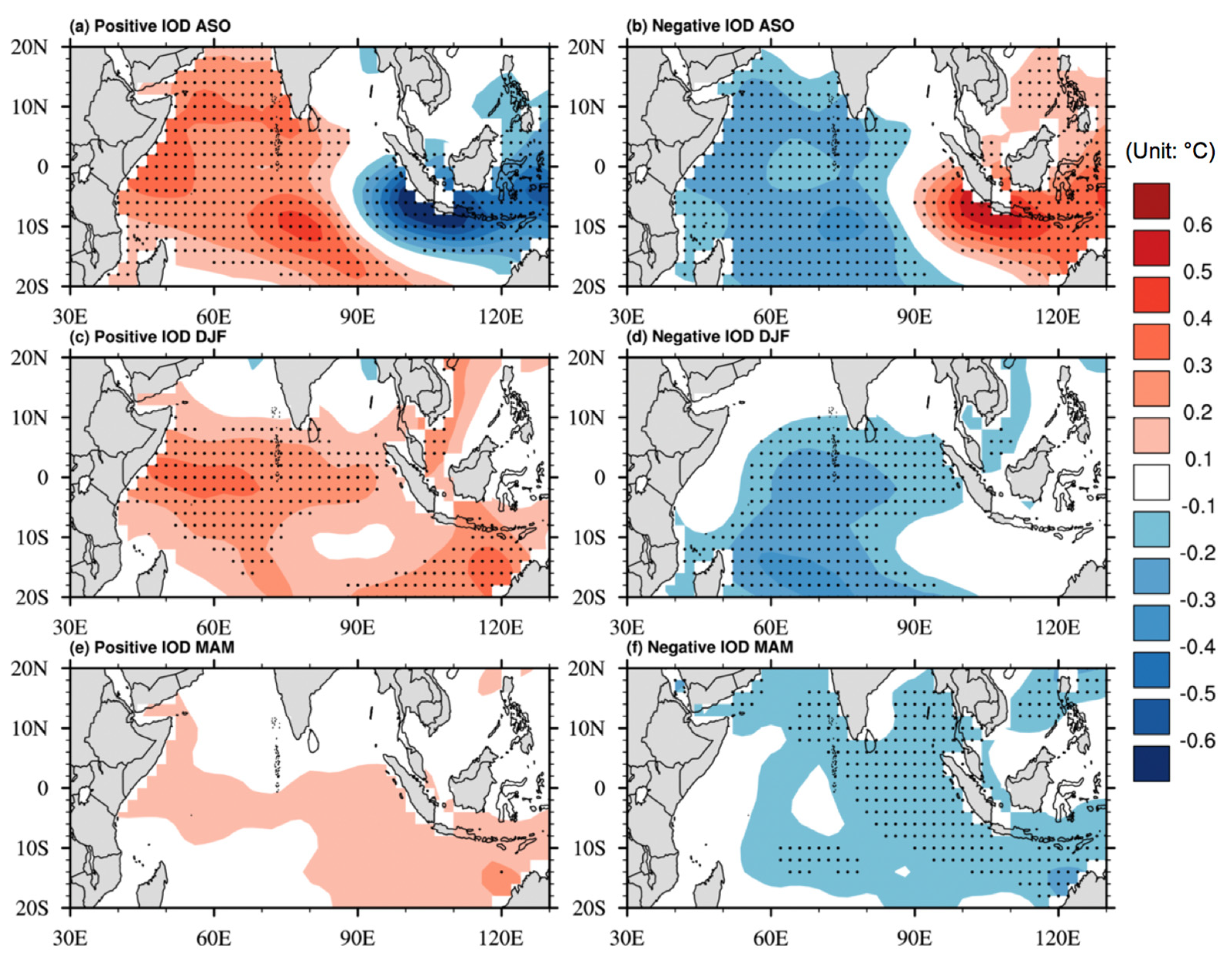
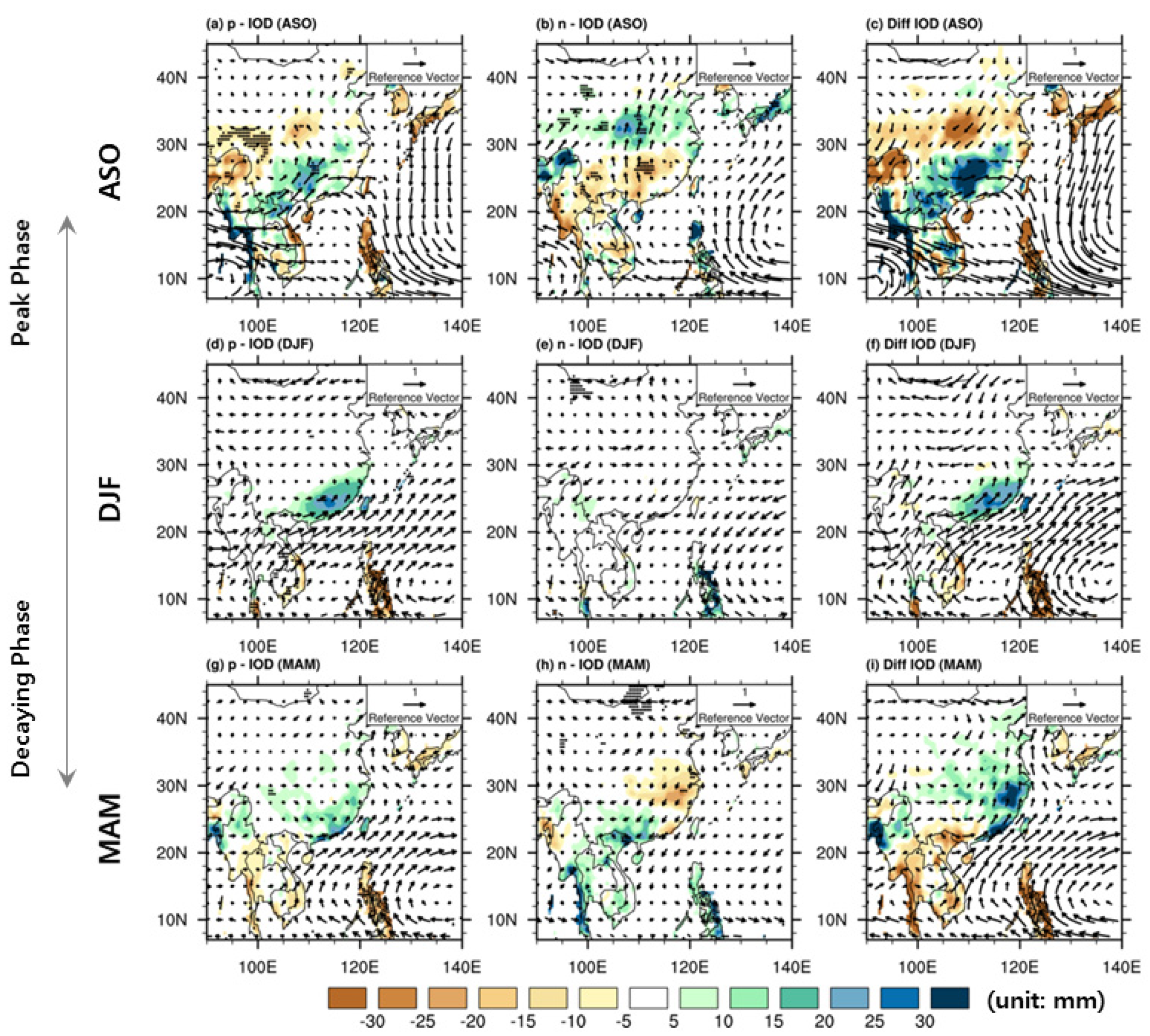
| River Basin | August–October | March–May | ||||
|---|---|---|---|---|---|---|
| p-IOD Years | n-IOD Years | p-IOD Years | n-IOD Years | p-IOD/El Niño | n-IOD/La Niña | |
| Han River | −11.0 | 0.8 | 6.5 | −7.4 | 7.0 (20.5) | −1.5 |
| Nakdong River | −26.8 | −2.0 | 2.6 | 2.3 | 13.6 (20.4) | 8.9 |
| Geum River | −24.6 | 4.3 | 4.0 | 3.9 | 11.8 (22.0) | −1.5 |
| Sumjin River | −26.0 | 5.2 | 3.1 | −5.2 | 18.8 (25.1) | 7.4 |
| Youngsan River | −25.9 | 6.0 | 9.4 | −3.4 | 13.3 (20.6) | 8.7 |
Publisher’s Note: MDPI stays neutral with regard to jurisdictional claims in published maps and institutional affiliations. |
© 2021 by the authors. Licensee MDPI, Basel, Switzerland. This article is an open access article distributed under the terms and conditions of the Creative Commons Attribution (CC BY) license (https://creativecommons.org/licenses/by/4.0/).
Share and Cite
Kim, J.-S.; Yoon, S.-K.; Oh, S.-M.; Chen, H. Seasonal Precipitation Variability and Non-Stationarity Based on the Evolution Pattern of the Indian Ocean Dipole over the East Asia Region. Remote Sens. 2021, 13, 1806. https://doi.org/10.3390/rs13091806
Kim J-S, Yoon S-K, Oh S-M, Chen H. Seasonal Precipitation Variability and Non-Stationarity Based on the Evolution Pattern of the Indian Ocean Dipole over the East Asia Region. Remote Sensing. 2021; 13(9):1806. https://doi.org/10.3390/rs13091806
Chicago/Turabian StyleKim, Jong-Suk, Sun-Kwon Yoon, Sang-Myeong Oh, and Hua Chen. 2021. "Seasonal Precipitation Variability and Non-Stationarity Based on the Evolution Pattern of the Indian Ocean Dipole over the East Asia Region" Remote Sensing 13, no. 9: 1806. https://doi.org/10.3390/rs13091806
APA StyleKim, J.-S., Yoon, S.-K., Oh, S.-M., & Chen, H. (2021). Seasonal Precipitation Variability and Non-Stationarity Based on the Evolution Pattern of the Indian Ocean Dipole over the East Asia Region. Remote Sensing, 13(9), 1806. https://doi.org/10.3390/rs13091806










